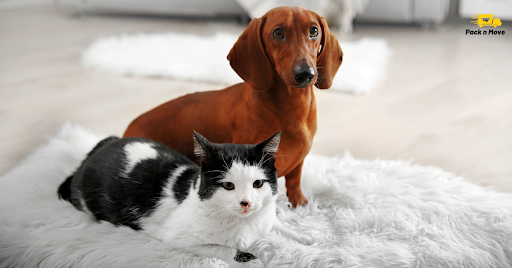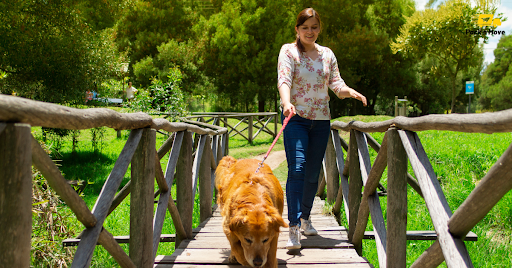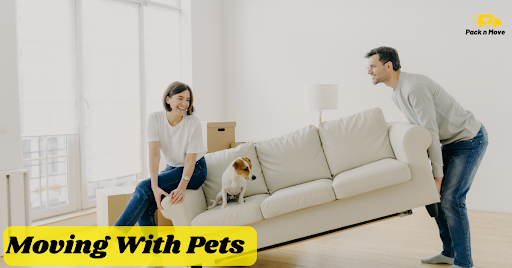Introduction
Moving house is an exciting milestone, but when you’re a pet owner, it adds another layer of responsibility. Pets thrive on stability, and the chaos of relocating can be unsettling for them. Moving with Pets isn’t just about packing their things; it’s about ensuring their comfort, safety, and well-being every step of the way.
This guide is your roadmap to a stress-free move with pets. From pre-move preparations to settling into your new home, you’ll learn practical tips to keep your furry, scaly, or feathery friends happy throughout the process.
Preparing Your Pet for the Move
Create a Safe and Familiar Space
Before the hustle of moving day begins, designate a pet room filled with familiar items such as their bedding, toys, and food bowls. This secure area serves as a retreat for your pet and helps them feel safe amidst the whirlwind of activity. Familiar smells and items can significantly ease their anxiety.
Additionally, reduce access to packed boxes and moving supplies, which can be dangerous. Keeping your pets away from the packing chaos not only keeps them calm but also prevents accidents or injuries.
Stick to Their Routine
Pets rely heavily on routines for a sense of stability. Maintain their walking, feeding times, and play schedules as closely as possible. This consistency helps reduce stress and gives them a sense of normalcy during the transition.
If possible, incorporate some extra playtime or snuggles to reassure them. This small effort can go a long way in helping your pets feel secure amidst the uncertainty of moving house.
Packing and Traveling with Pets
Pack Your Pet’s Essentials Separately
Prepare a dedicated travel bag for your pet with their essentials: food, water, litter trays, medications, and favorite toys. This ensures that everything they need is easily accessible during the journey and the first few days in your new home.
Don’t forget to include items like a travel bowl, leash, or carrier suitable for their size. Having their necessities handy allows you to focus on the move without scrambling for their essentials.
Use Calming Aids
If your pet tends to get anxious during car travel, consider using calming aids such as pheromone diffusers or natural scents like lavender. These aids can help keep their nerves at bay during the trip.
For animals like tropical fish, reptiles, or amphibians, ensure their tanks are securely packed with appropriate support to avoid damage. Proper preparation is crucial for their health and safety during transit.
Prepping Your New Home for Pets

Pet-Proof the Space
Your new home might have hazards you didn’t anticipate. Check for poisonous plants, loose wires, sharp tools, or small objects that could pose a choking risk. If you have outdoor space, inspect fences and gates for gaps to ensure your pet doesn’t wander off.
For families with dogs, a secure garden is essential. Whether it’s a yellow anaconda or a lively puppy, every pet needs a safe and controlled environment to prevent accidents.
Set Up a Safe Zone
Before your pet explores the entire house, create a safe zone filled with their familiar items. This room will act as their sanctuary while they adjust to the new environment. Setting up their bedding, water bowls, and favorite toys in one area can give them a sense of security and comfort.
The Moving Day Checklist
Inform Movers About Your Pets
Whether you’ve hired a removal company or enlisted friends, it’s crucial to let them know you have pets. This avoids any surprises and ensures that movers take precautions to avoid startling or accidentally letting your pets out.
On moving day, keep your pets in a quiet room away from the chaos. This prevents them from feeling overwhelmed by the constant noise, packed boxes, and presence of strangers like the moving men.
Feed Pets Early and Lightly
Before the journey, feed your pets lightly to avoid travel sickness. Ensure they have access to fresh water, but avoid overfeeding, especially if the trip is long. Plan for rest breaks during car travel so your pet can stretch, hydrate, and use the toilet.
Helping Pets Settle in Your New Home
Unpack Their Items First
Before anything else, set up their designated area with familiar items like their bedding, food bowls, and scratching post. The scent of these items helps pets feel at home. This is especially important for territorial cats, as it reduces their anxiety.
Allow your pets to stay in this zone while you unpack other parts of the house. Gradually introduce them to new areas once they seem comfortable and curious.
Allow Gradual Exploration
Let your pets explore your new home at their own pace. For cats, it’s recommended to keep them indoors for at least two weeks to prevent them from wandering or getting lost. Dogs can benefit from leashed walks around the house or garden as they adjust.
Exploring the New Neighborhood
Familiarize Your Pet with the Area
Take your dog on regular walks around the new neighborhood. This introduces them to new smells, sounds, and surroundings. Identify a safe walking route and take note of local parks and enclosed outdoor spaces where your dog can safely roam.
For cats, gradually introduce them to the garden or outdoor areas under supervision. Monitor for potential escape points or hazards to ensure their safety.
Check for Safety
Ensure your yard is secure with proper fencing and that gates are locked. Look out for harmful items like garden pots containing poisonous plants or broken tools that could injure your pet. A safe environment is crucial for their well-being.
Health and Safety Essentials
Update Identification Details
Once you’ve moved, update your pet’s microchip and ID tag with your new address. This ensures they can be easily returned if they wander off in the new area.If you don’t already have pet insurance, now is the time to consider it. Unexpected medical costs in a new place can be overwhelming.
Register with a Local Vet
Find a veterinarian in your area and schedule an introductory visit. Ensure your pet’s vaccinations and medical records are up-to-date to avoid future health complications.
Handling Behavioral Adjustments
Be Patient
Adjusting to a new home takes time for pets, and they may exhibit behavioral issues like accidents or increased anxiety. Be patient and avoid punishment, focusing instead on reward-based training to encourage positive behavior.
Understanding your pet’s needs and showing them extra attention will reassure them during this transition. Regular snuggles, playtime, and sticking to a feeding schedule can work wonders.
Spend Quality Time

Make time for activities your pet loves. Whether it’s walkies for dogs or interactive play for cats, these moments build trust and confidence, making their adjustment period smoother.
Conclusion
Moving house can be a stressful experience for both humans and pets, but with thoughtful preparation and a calm approach, it’s possible to make the transition seamless. By sticking to routines, creating safe spaces, and prioritizing your pets’ wellbeing, you can turn this potentially chaotic event into a positive experience for your furry family members.
Your pets are more than companions; they’re family. Treat them with the care and patience they deserve, and they’ll settle into their new home in no time.
Frequently Asked Questions (FAQs)
1. How do I reduce my pet’s stress on moving day?
Keep them in a quiet room, use calming aids, and consider hiring a pet sitter if needed.
2. How can I prepare my garden for my pets?
Ensure it’s fenced securely, free of poisonous plants, and safe from escape points.
3. What should I pack in my pet’s essentials bag?
Include food, water bowls, bedding, toys, medications, and a leash or carrier.
4. How long should I wait before letting my cat explore outdoors?
Keep them indoors for at least two weeks to prevent them from getting lost or confused.
5. Why is updating my pet’s microchip important?
If your pet gets lost, updated tagging ensures they can be returned to you quickly.
